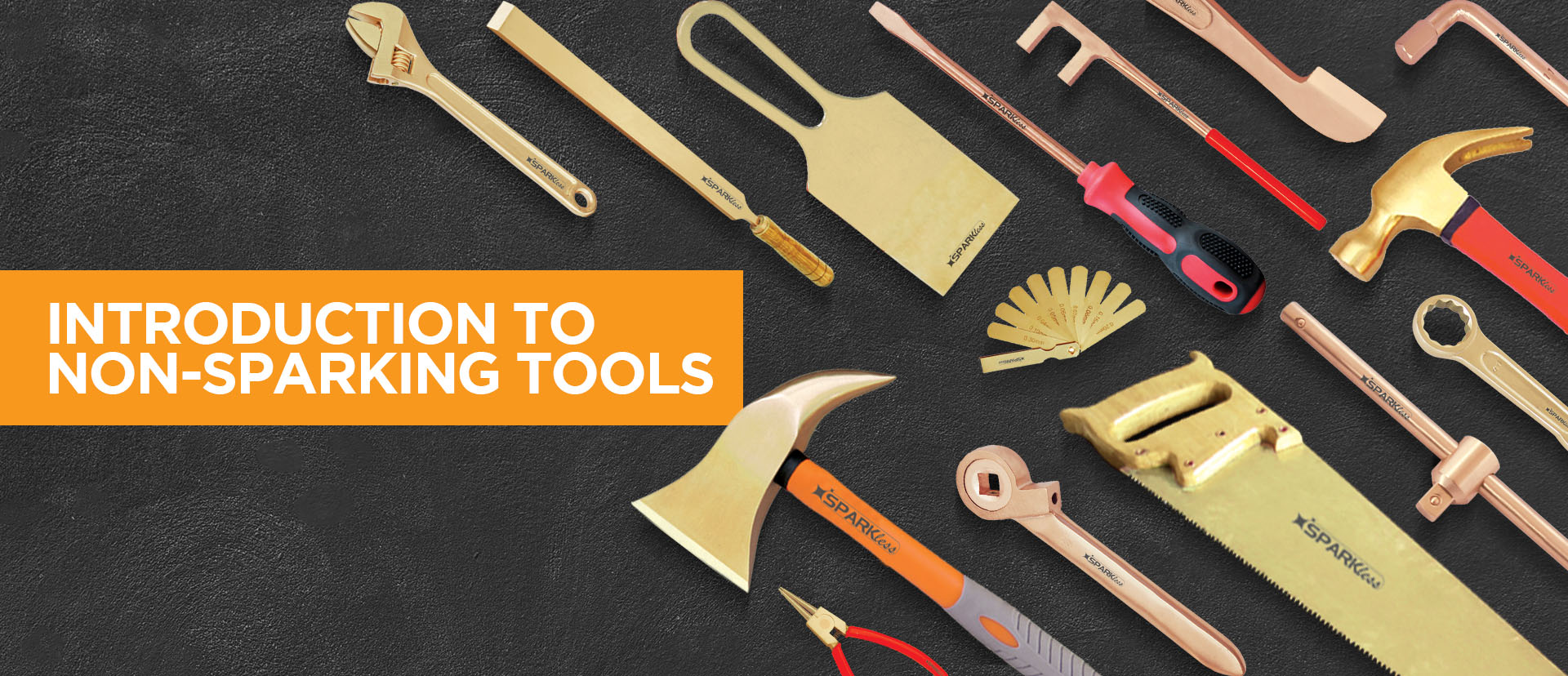
introduction to non-sparking tools
What are Non-sparking tools?
Non-Sparking tools are hand tools made from materials (usually copper alloys) that give it a special non-sparking property. This property ensures that these tools do not emit high temperature sparks. Regular steel tools made from Chrome Vanadium and ferrous alloys can emit frictional sparks. These sparks can acquire higher temperature and have the potential to ignite flammable gases and vapours. Non-sparking tools may emit cold sparks with very low heat content which cannot ignite a flammable atmosphere of gas
What are these tools made up of?
Our Sparkles ® non-sparking tools are made from 2 alloys – Aluminum Bronze and Beryllium Copper. Both these alloys are tested as per IS4595 standard and are certified non-sparking. Beryllium Copper alloy has better mechanical properties and is the strongest known alloy of Copper. We recommend these tools to our client because of the superior performance and life they get during use. Aluminum Bronze is also another copper alloy that is used for non-sparking tools. Aluminum Bronze is more economical than Beryllium Copper and hence popular. Few scrupulous companies offer tools made of brass. These should be avoided as brass is too soft to be used for wrenches. End-users need to be vigilant about the tools they procure.
Who needs to use these tools?
Hand tools are an integral set of tools for any industry. Many industries including but not limited to Oil & Gas, Chemicals, Pharmaceuticals, Fertilizers, Steel, Automobiles, FMCG, Petrochemical Companies etc. have their operators performing maintenance or daily operations in specially identified zones within their plant. These zones are identified as hazardous and operators in these zones should be mandated to use non-sparking tools

Where should we use them?
Non-Sparking tools should be used in any location where an atmosphere of flammable gas can or does form. For example an operator performing an unloading operation of Motor Oil Spirit or HSD should use non-sparking tools. Both petrol and diesel easily vaporize creating a flammable atmosphere and use of regular tools poses a major fire hazard. Another example can be of an operator performing maintenance in a gas (LPG/NG) pipeline. Even though the pipeline section may have been isolated there is always a possibility of residual gases. Every plant will need to identify such locations within and develop appropriate SOPs to include non-sparking tools
Correct selection of tools:
Different hand tools are designed for different applications. Choosing the correct non-sparking tool for your application is the most important step for any company. While it may sound obvious we have seen many users procuring incorrect tools for their application. When these tools are put to use, end users face several challenges and wrongly assume the tool is not performing. We have been assisting our customers match the correct tool to the job and in many cases where standard tools cannot meet the requirement we have developed customized tooling solutions. This ensures adoption of non-sparking tools at the workplace which turn ensures safety.
How to use non-sparking tools correctly?
Once you have matched the correct tool to your application it is equally important to know the limits of each tool. In the case of standard hand tools they have been designed for a specific purpose and using it outside this will mostly constitute a misuse. An example is – double ended spanners are meant to be used by hand only. Hammering a double end spanner or using a pipe to increase leverage and apply more torque are 2 applications for which it is not designed and is a gross misuse of the tool. Similarly hammering a screwdriver or using a wrench as a hammer is again gross misuse. All of these are an indication that the correct tool was not matched for your application and tools are being misused to ‘get the work done’. This leads to performance issues and life of the tool is greatly reduced while increasing safety risks enormously. We at Bombay Tools offer our customers tool usage guide along with the supply of tools which has common sense advice on what a tool should be used for and what it should not be used for
Final Thoughts
Lack of Non-Sparking tools within the industry has caused many accidents. There are several case studies that have identified frictional sparks from hand tools causing fire. Plant operators and maintenance personnel need to follow these 3 steps to mitigate the risk of fire:
- Identify and designate flammable zones correctly
- Select the correct set of hand tools for the application within that zone
- Ensure that the tools are used correctly by your operator. This 3-step process will greatly improve safety at your plant
